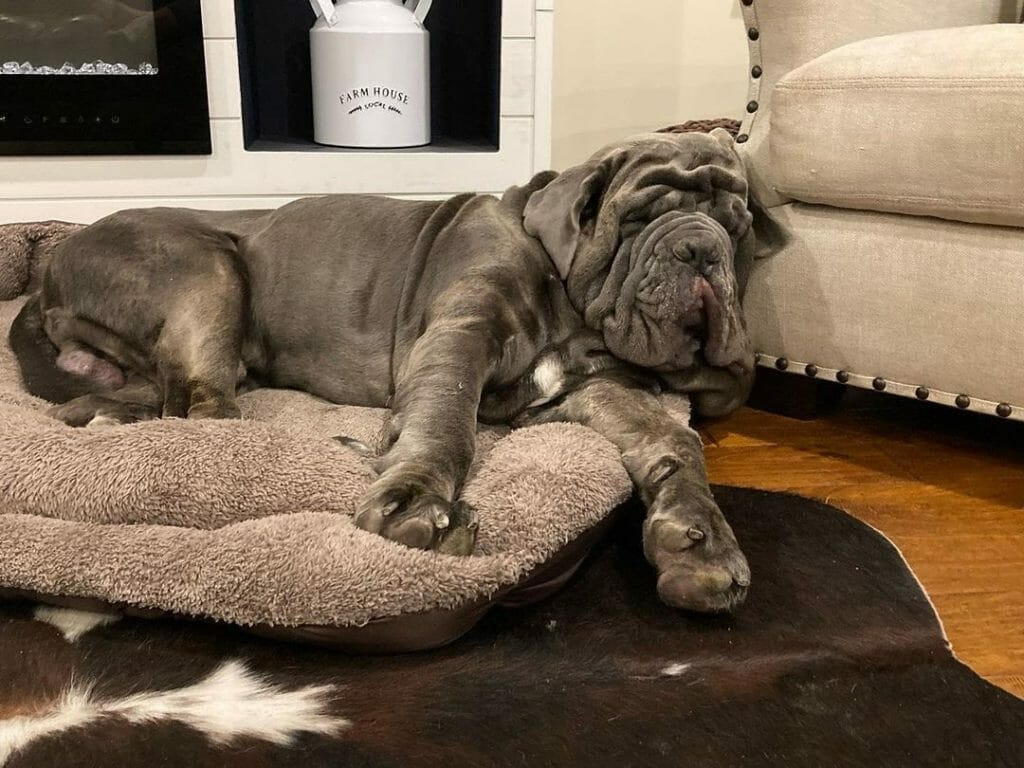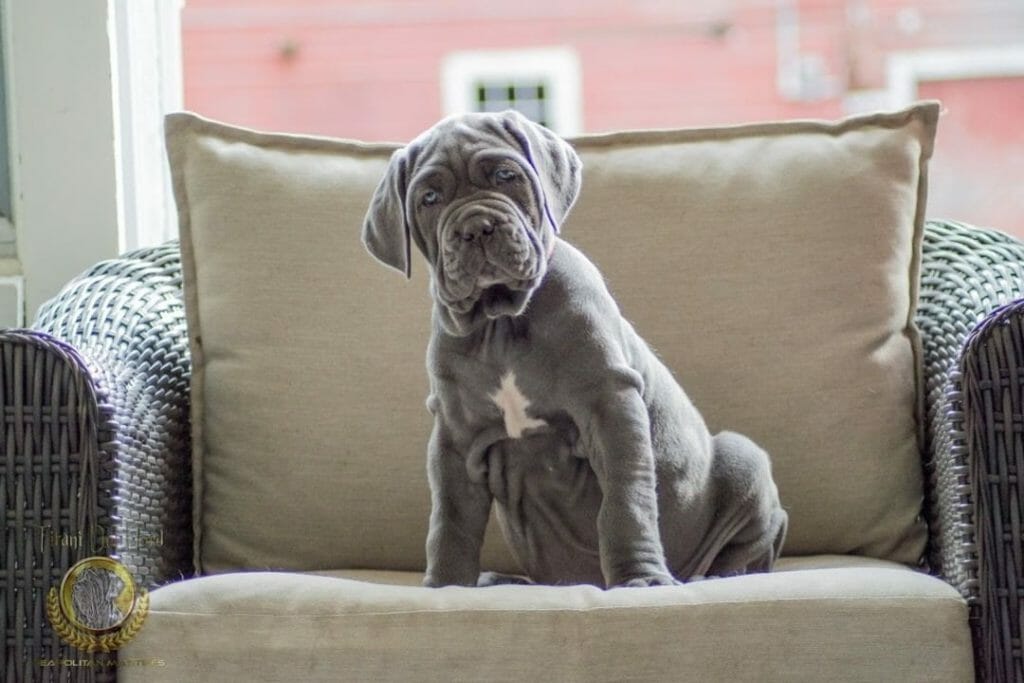Are Neapolitan Mastiffs Hypoallergenic? 6 Tips for Allergic Families!
If you are into the Neapolitan Mastiff, you have to know that this dog is far from non-allergenic, but fortunately, there are ways to manage allergy symptoms. Searching for the right dog breed that won’t trigger your allergies is not easy, especially that any available hypoallergenic dog breeds are not for everyone.


Truth be told, it is not that overwhelming to have a four-legged furry friend roaming inside the house with a family member who is sensitive to pets. You may ask, “How can this be possible?” This blog post will give you all tips and answers for a happier pet experience.
Table of Contents
How Much Do Neapolitan Mastiffs Shed?
The Neapolitan Mastiff breed is an average shedder. He has a loose-fitting double-layered coat which he constantly lets go of all year round. Since the dog sheds regularly, it is recommended that he should be brushed weekly to manage his shedding. To better control his dander, you can brush him more often than that, whatever works for you!


Prepare your bristle brush and other grooming tools for heavier shedding during spring and fall. In the spring season, your Neapolitan Mastiff’s body will gradually adjust to the changing warm climate. Therefore, his coat will become lighter. The same thing will happen in the fall season. Your dog will replace his old coat with a new and thicker one to keep him warm during wintertime.
These are commonly the periods when lumps or a great amount of hair fall end up sticking in various places inside your home!
What Is the Real Cause of Dog Allergies?
We often think that what causes dog allergies is our pets’ fur, but the reality is, our Neapolitan Mastiff produces a certain protein called Fel D1 which causes our bodies to react, especially when the immune system interprets it as a foreign matter. As a reaction, the body of the person who is allergic to the substance will send in signals to release antibodies that will eventually “stop the substance.”
The cells will then produce histamine and this causes blood vessels to expand and such a system ends up triggering allergy symptoms.
The Fel D1 that is found on the Neapolitan Mastiff’s coat is spread when he licks himself. The same protein can be found in his saliva, urine, and feces.
Strengthen Your Children’s Immune System
If your family has a history of pet allergies, there is something that you can do about it. Let’s say, for example, you don’t want your kids to be allergic to pets, study shows that kids who live with pets while they were infants are less likely to develop a reaction or allergies later in their childhood. Moreover, it has been suggested that the more pets they were exposed to, the better.
Of course, pet ownership is just one factor in decreasing one’s chances of getting pet allergies. Other contributing factors include kids having siblings or being born in a normal delivery.
The Signs and Symptoms of Pet Allergies


If you suspect that you or one of your family members is allergic to dogs, it is a wise decision to spend a bit of your time first with your prospective Neapolitan Mastiff. By doing so, not only would you be able to see if you are both a match but as well as determine if he can trigger allergies or not. To have lesser risks, you may visit an allergist before you head to your local animal shelter.
An allergist is a specialist who diagnoses and treats allergies. He would be able to identify what kind of allergy you have and what reactions may be exhibited once your body reacts to a certain allergen.
For pet allergies, here are the common signs and symptoms:
- Itchy, red, and/or watery eyes
- Constant sneezing
- Runny nose
- Nasal congestion
- Itchy throat, or roof of the mouth, and nose
- Constant coughing
- Postnasal drip
- Blue-colored or swollen under-eye skin
- Constant upward rubbing of the nose
- Facial pain and pressure
Asthma may also happen during your allergy phase and more symptoms may show such as:
- Chest pain or tightness
- Audible whistling when exhaling
- Difficulty to breathe
- Inability to sleep due to wheezing, coughing, or shortness of breath
6 Proven Tips on How to Manage Pet Allergies


Most allergists agree that the best way to avoid having a reaction to pets is to avoid them totally, but that is not the easiest option when you have a strong likeness toward dogs like the gentle Neapolitan Mastiff. There are numerous medications available out there, but transforming how you live your life makes a big difference too!
Here are what you should do to manage pet allergies while owning the massive Neapolitan Mastiff:
- Keep a distance from your dog. Never touch, pet, or kiss your Neapolitan Mastiff. If you have had contact, wash the area immediately.
- Be wary of guests who have dogs. Dander can cling to clothes and other items. Even if your guests don’t bring their dogs with them when they go out to meet you, the allergen is still present on their clothes and, therefore, putting you at risk of contact.
- Use your prescribed medicine. If you know that you are going to come in contact with a dog, it is best if you take your meds early to prevent symptoms from developing.
- Have an easier-to-clean home. Identify which of your furniture is most likely to catch dander and replace them with those who have fabrics that can’t be easily penetrated with allergens. Ditch rugs, drapes, and carpets!
- Clean your home regularly. You may not know it, but your Neapolitan Mastiff’s dander can fly anywhere inside your home. Clean your surroundings as often as you can and install a high-quality HEPA filter to maintain cleaner and fresher air inside.
- Keep your Neapolitan Mastiff out of your bedroom. This is the last place where your dog should be. Give him a limited area which he can go to.
4 Sure Ways to Cure Pet Allergies
There are standard allergy drugs your doctor may recommend in combating pet allergies. Some are over-the-counter products while others may need a prescription:
- Antihistamines. This drug blocks the effects that trigger pet allergies. You can easily purchase them on the counter on various labels like cetirizine, Benadryl, Allegra, Claritin, and Astelin. Some antihistamines are in the form of nasal sprays.
- Nasal Steroids. These come in sprays and they help in relieving allergy symptoms. The first action this drug takes is to calm the inflammation. While others need a prescription, Flonase and Rhinocort Allergy are available as OTC products.
- Decongestants. Its primary role is to relieve congestion and nose swelling. Sudafed and Allegra-D are the common purchases of those who suffer from pet allergies.
- Allergy shots. Another option you might consider is to take allergy shots. This may not be for everyone, especially that it will take years to complete. Nevertheless, this has helped countless allergenic individuals in their experience with pets. Talk to your doctor regarding all the pros and cons of going for this option.
